One of the most thrilling aspects of birdwatching is the almost endless array of shapes, sizes, and colors that our feathered friends come in.
If you’ve been out birding and spotted a bird with an orange head, you might be wondering what it could be. We’re here to help.
In this list, we’ll be exploring the most iconic birds of North America possessing orange heads. The list was great fun to put together and the diversity of birds is breathtaking. From wading birds like ruffs and avocets to orange-headed woodpeckers and orioles, you’re bound to be impressed by the variety.
Without further ado, let’s get stuck into the bird species of North America that have heads like orange beacons, beckoning you to get to know them better. You soon will.
Orange-Headed Birds of the United States and Canada
Rufous Hummingbird
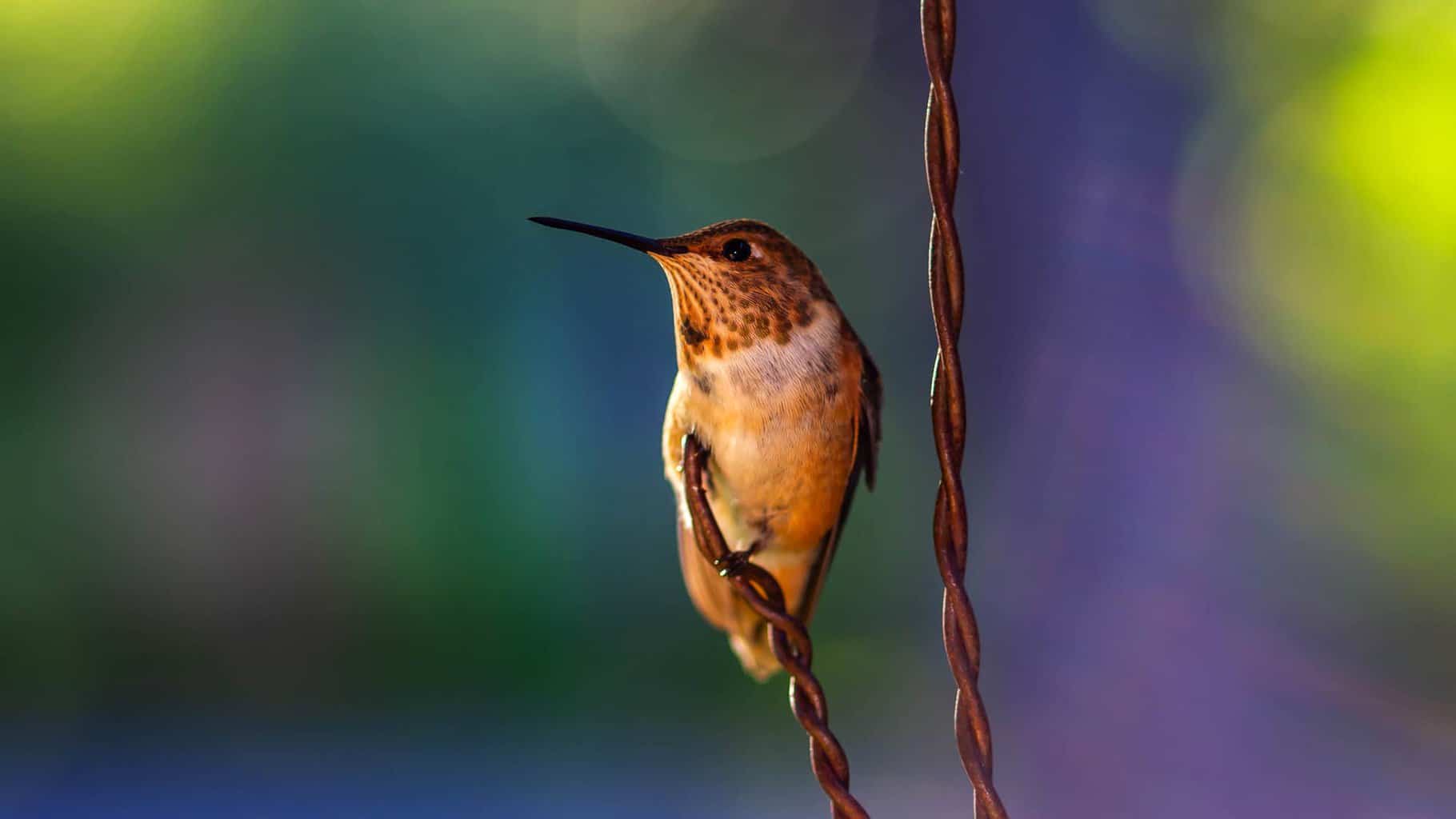
‘Rufous’ is one of those colors that is rarely referred to outside the bird world. It refers to a rusty red or dusty-orange pigment that aptly describes the plumage of so many bird species. The rufous hummingbird (Selasphorus rufus) is one good example!
One of the most common hummingbirds of the Northwestern states in summer, rufous hummingbirds also overwinter in the Southeast. During their spring and fall migrations, they can be seen anywhere in between.
Rufous hummingbirds nest in open coniferous forests and woodlands near water. Migratory birds are also commonly found feeding in mountain meadows.
Allen’s Hummingbird
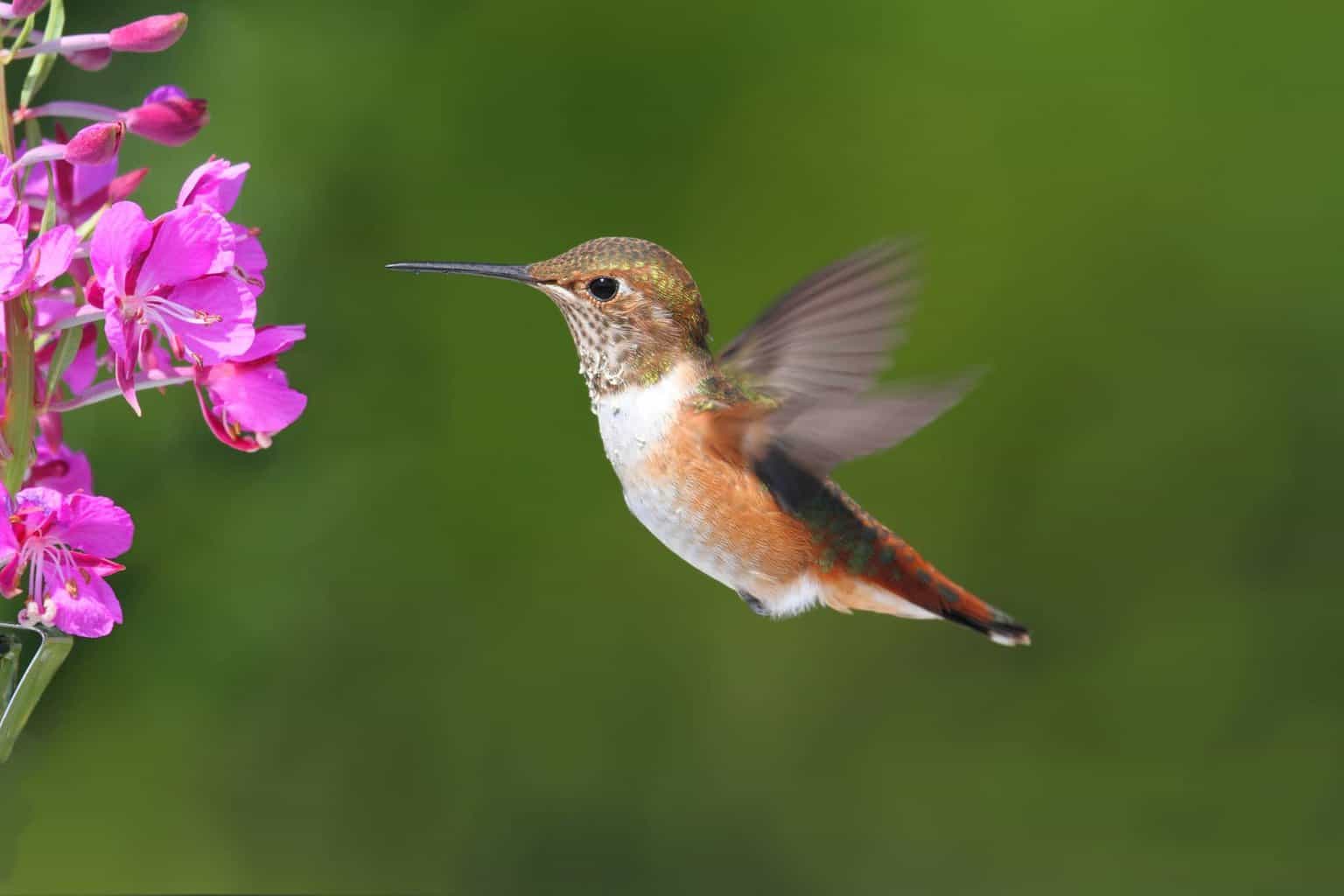
A close cousin of the Rufous Hummingbird is Allen’s Hummingbird (Selasphorus sasin). Because males of this species also possess a bright orange throat, they’re the only hummer that can be easily confused with the true Rufous species.
These birds have a much more confined range than rufous hummingbirds, though, and are usually only seen in coastal chaparral and young woodlands near water.
Males of this species are especially territorial and will aggressively drive away other hummingbird species from their favorite flowers and feeders.
Western Tanager
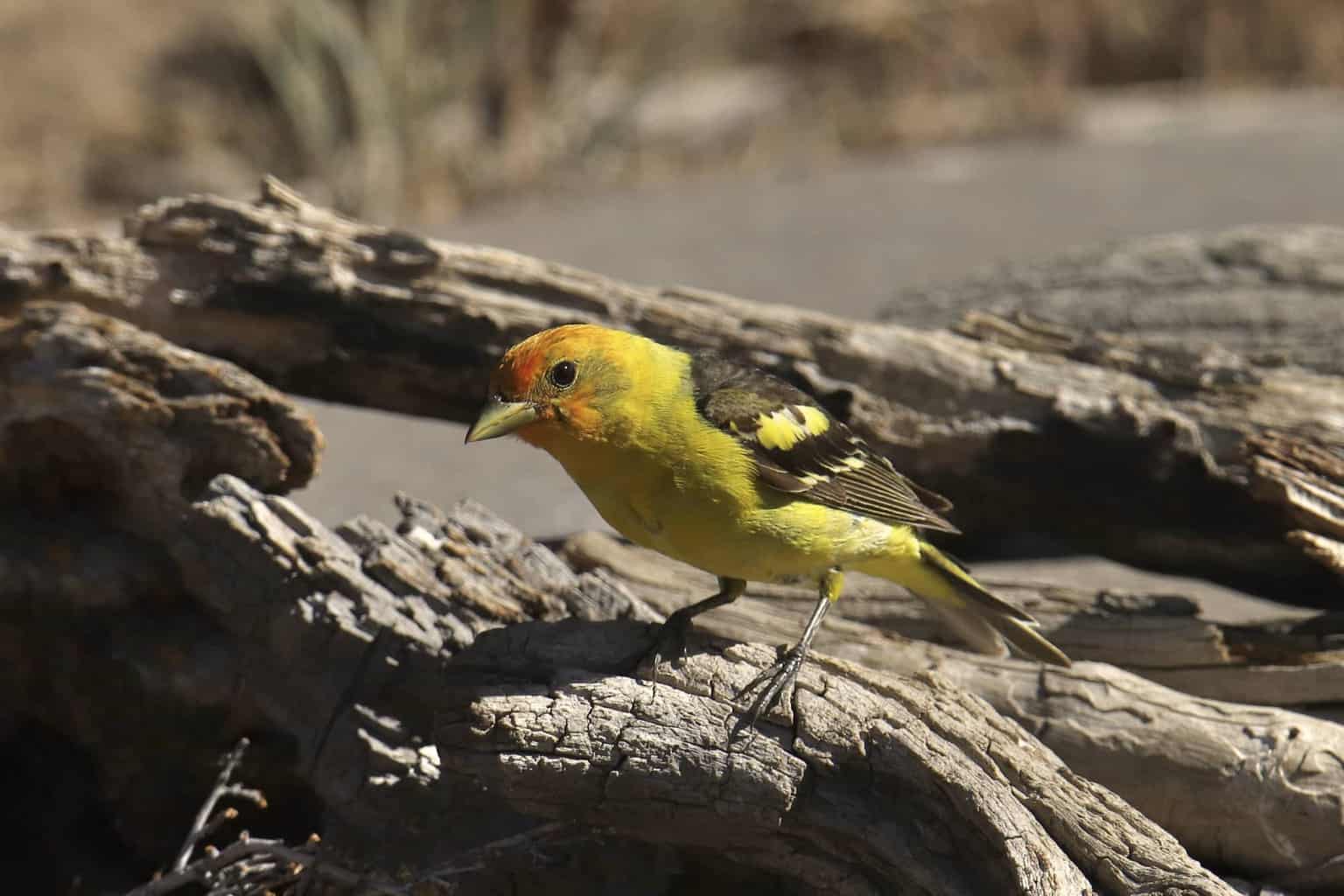
One of the most striking orange-headed birds in North America has to be the Western Tanager (Piranga ludoviciana). While some might argue the head is more of a scarlet color, there is also an orange region where the red plumage blends into a yellow torso.
Western tanagers are common in both coniferous and mixed forests in the Western United States and Canada. Their breeding range includes coastal regions as well as much of the Rocky Mountains. During migration, they can be seen throughout the West.
Western tanagers are mostly solitary birds, occupying the upper layers of the forest canopy. They feed primarily on insects and larvae from tree leaves.
North American Orioles

Some of the most striking birds with orange heads in North America are the Orioles (Genus Icterus).
The Spot-Breasted Oriole, Hooded Oriole, Altamira Oriole, Streak-backed Oriole, and Bullock’s Oriole all have orange heads, whereas their cousin the yellow-headed blackbird has a darker yellow head. They’re also closely related to grackles, cowbirds, and meadowlarks.
All members of the New World Oriole family can be found in groups when not breeding. They typically inhabit woodlands and feed on insects, fruit, and even nectar.
Orioles are also famous for the beautiful pendulous nests they build hanging from high trees.
Vermilion Flycatcher
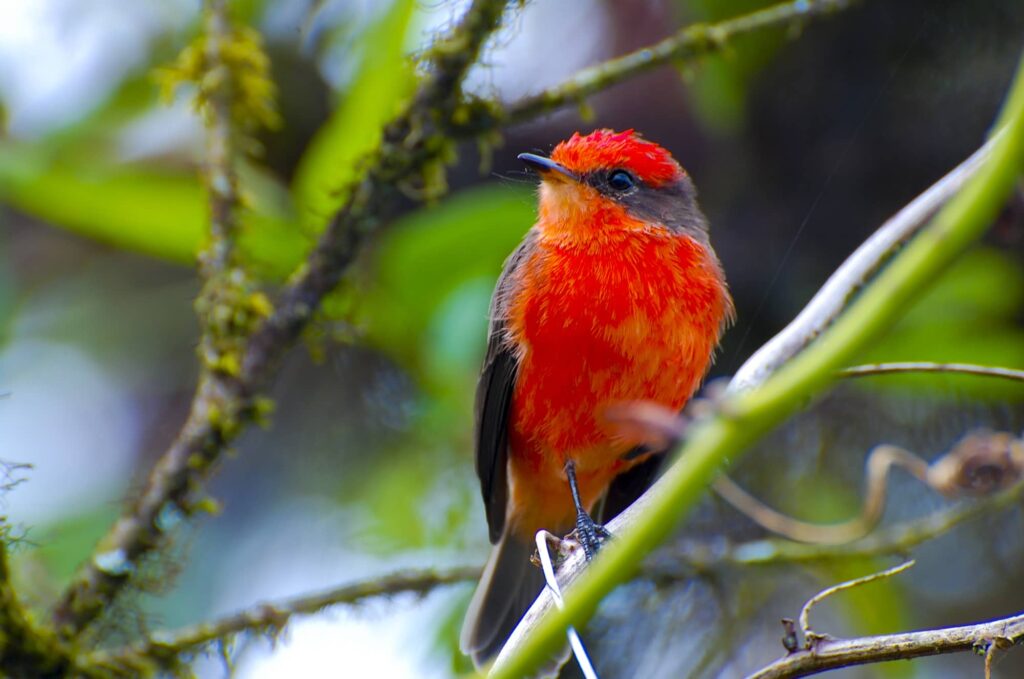
The million-dollar question is: does the Vermillion Flycatcher (Pyrocephalus obscurus) have a red or orange head?
Since the color vermilion is defined as somewhere between orange and red, we felt that the vermilion flycatcher deserved to make the list!
One of the most striking small birds in the USA, the vermilion flycatcher can only be seen in the most Southerly states. Breeding from Texas to California, they also overwinter in Southeastern states like Mississippi and Florida.
As their name suggests, vermilion flycatchers specialize in feeding on small flying insects. It can be great fun watching them hunting. Look out for them darting out to catch their prey before looping back to their favorite low tree branch or fence post.
Greater Prairie-Chicken

The greater prairie chicken (Tympanuchus cupido), was once a common bird among The Great Plains but is now extremely rare and extinct in much of its former range due to hunting and habitat loss.
Like their cousins, the sharp-tailed grouse and less prairie chicken, the greater prairie chicken has a large, plump body, and is the largest member of the genus.
The males of all three species have impressive orange patches on their heads and necks, but the greater prairie chicken probably has the most colorful and striking features of all.
An amazing feature of these stocky birds is the sounds that the male makes during the courtship ritual known as ‘booming’.
According to Sibley’s Guide to Birds, his long, hooting moans sound a bit like air blown across the top of a bottle. Wild clucking noises and foot stamping accompany the hoots, making their ‘booming’ ritual a spectacle to behold!
- Sibley Guide To Birds, 2nd Ed
- Sibley, David Allen (Author)
- English (Publication Language)
Last update on 2024-04-27 / Affiliate links / Images from Amazon Product Advertising API
Redhead Duck

It’s the male redhead duck (Aythya americana) that earned the species its common name, but in truth, its head is more orange than red!
Males also have a bold black chest and underside and gray back and wings in the breeding season, whereas females remain tawny-brown throughout the year.
Redhead ducks are locally common in the Southern United States and Mexico during the winter and mostly migrate to the Western States, Canada, and even Alaska for breeding.
This species of diving duck spends its winters on the open water of lakes and bays. In spring they nest in ponds with a mixture of open water and dense reedy vegetation.
Red-Headed Woodpecker

An unmistakable member of the woodpecker family is the red-headed woodpecker (Melanerpes erythrocephalus).
As their name suggests, mature red-headed woodpeckers of both sexes have striking red heads, but they could also appear orange according to the type of light you see them in.
Red-headed woodpeckers reside in the Southeastern United States throughout the year but also migrate to the midwest and beyond for the breeding season. They prefer open woodland habitats, including clear-cut areas where only a few trees are left standing.
Red-Bellied Woodpecker
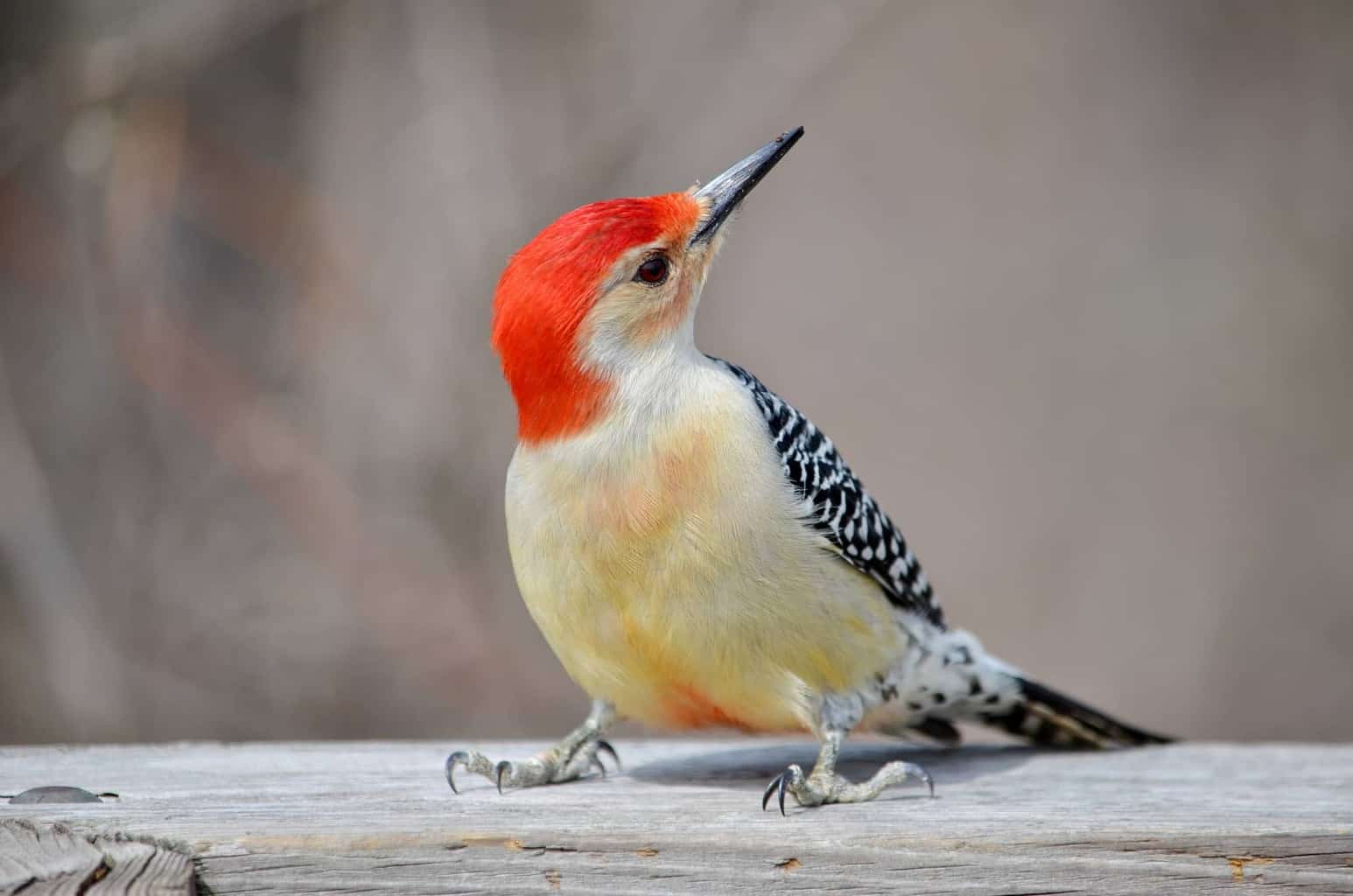
While some might insist that the red-headed woodpecker is more red than orange, I’d strongly argue that the golden-fronted woodpecker (Melanerpes aurifrons) truly qualifies as a bird with an orange head!
Whereas females only have a yellow-orange patch on the back of their head, the male of the species possesses a full deep orange crown. As with other members of their genus, the stripey black and white backs of these woodpeckers are also highly attractive.
Golden-fronted woodpeckers aren’t widespread in the United States but are locally common in dry mature deciduous woodlands in Texas and Southwestern Oklahoma.
Their cousin the red-bellied woodpecker (Melanerpes carolinus) is much more widespread but once again, it might be deemed to have a red, rather than orange head!
Ruff

Now, perhaps the most extraordinary bird on our list. The ruff (Calidris pugnax) is a medium-sized wading bird that’s most commonly found in northern Eurasia during the breeding season and in Sub-Saharan Africa during the winter.
This wandering sandpiper species, however, seems discontent with any sort of defined range and can turn up just about anywhere in the world, including India, China, Australia, and North America.
Forming flocks of up to a million birds, they seek out shallow wetlands and muddy ponds. They occasionally show up on the East and West Coasts of the United States, from Florida to Alaska.
Just as unpredictable as their migratory range is the incredible breeding plumage of the males. Some display a beautiful snowy white or bluish-black head and neck, while others present a deep rusty orange head and bill.
Describing the ruff’s otherworldly courtship rituals and sparring battles between males would simply never do it justice, so I thoroughly recommend watching this video to witness their famous breeding behavior for yourself.
Red Knot

Another colorful member of the sandpiper family is the red knot (Calidris canutus). Although their name suggests otherwise, the breeding plumage of these sturdy wading birds is a salmon pink-orange color rather than red.
Red knots are locally common along sandy beaches along the Atlantic and Pacific Coasts of the USA in winter but migrate north to breed in the marshlands of the arctic tundra of Canada in the spring.
Look out for red knots walking along the shoreline, picking up shellfish and crustaceans as they go. They’re usually seen in flocks during the winter, often mixing with other sandpipers.
American Avocet

Surely one of the most elegant waders in the world, the American avocet (Recurvirostra americana) is a large sandpiper with a mostly white body and black stripes on its back. Their long, slender upturned bill and long gray legs make them unlike any other bird on the continent.
Between March and August, both sexes develop a rusty-brown to orange neck. The main difference between males and females is that females have a more pronounced curve to their bill than males.
Widespread in North America, avocets overwinter along both Atlantic and Pacific coasts but mostly fly inland to breed along edges of weedy ponds and lakes, especially in the West.
American avocets feed by gracefully sweeping their bills from side to side through shallow water. They’re usually seen in flocks and can sometimes march together in groups of hundreds of birds.
Flame Colored Tanager

Male flame-colored tanagers (Piranga bidentata) are truly stunning, tropical-looking birds with bright orange-yellow heads and throats. The reason that they’re relegated to the bottom of our list is that they rarely occur in the USA, but do occasionally wander over the border from their regular range in Mexico.
The pine and oak woods along the mountain canyons of Arizona and Texas are the only places you might see these birds in The Union, but they have been recorded nesting in the region.
A close relative of the Western Tanager that we mentioned earlier, the two species have been known to hybridize where their ranges overlap.
Wrap Up
Wow, what a list! We hope you’re as thrilled by America’s incredible bright-headed birds as we are.
Now that you’re familiar with most orange-headed birds of North America, you might be curious to learn about the continent’s wealth of red birds as well. Guess what? We’ve compiled a stunning list of those, too.

